Brown Ray
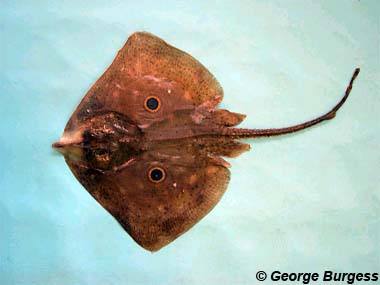
Raja miraletus
These rays have wide, diamond-shaped pectoral discs that are brown to reddish-brown and covered in dark spots, and two distinct eye spots in rich blue outlined in dark purple and then light yellow. From pointed snout to stout tail, they can grow to around 24 inches long, and it has two very small dorsal fins near the end of the tail.
It generally lives in the eastern Atlantic and Mediterranean, from marine salt water to brackish water, along soft bottoms of the sea floor. It is considered harmless to humans.
Order: Rajiformes
Family: Rajidae
Genus: Raja
Species: miraletus
Common Names
English language common names include brown ray, brown skate, homelyn cuckoo ray, homelyn mirror ray, homelyn sandy ray, skate, twineye ray and twineye skate. Other common names are arzilla (Italian), aynalivatoz baligi (Turkish), bachada escrita (Spanish), barakula (Croatian), chiamida (Italian), clavellada (Spanish), excrita (Spanish), grisol (Spanish), ikara (French), matovatos (Greek), occhhialina (Italian), peilirausku (Finnish), peixe-areia (Portuguese), picara liscia (Italian), picara quattrocchi (Italian), pichira fimminedda (Italian), pichira liscia (Italian), quatrochi (Italian), quattrocchi (Italian), quattuecchi (Italian), racho de escrita (Spanish), raia-azul (Portuguese), raia-de-dos-olhos (Portuguese), raia-de-espelhos (Portuguese), raia-de-quatro-olhos (Portuguese), raie (French), raie florifère (French), raie miraillée (French), raie miroir (French), raie zéro (French), raja de espejos (Spanish), raja liscia (Italian), raja lixxa (Maltese), raja motyl (Polish), raja occhialuta (Italian), raja petruza (Maltese), raja quattrocchi (Italian), rajada de miralls (Catalan), rajada de San Pere (Spanish), rajada limpia (Spanish), rasa quatroci (Italian), rasa sfeuggoena (Italian), rascia liscia (Italian), ratjada (Spanish), raya de espejos (Spanish), raya espejuelo (Spanish), raya limpia (Spanish), raya vera (Spanish), razza argentina (Italian), razza occhiuta (Italian), razza quattrocchi (Italian), razza stellina (Italian), rejnok skvrnooký (Czech), retjada (Spanish), rog (Afrikaans), scritta a quattrogus (Italian), spegelrocka (Swedish), spejlrokke (Danish), spiegelrochen (German), spiegelrog (Dutch), tappacunnu (Italian), tatra (Ewe), tchibouèla (Vili), tweeoog-rog (Afrikaans), Vieräagiger Spiegelrochen (German), vulpe cu patru ochi (Rumanian), zerra (French), zoun (Fon Gbe), and zweifleckiger rochen (German).
Importance to Humans
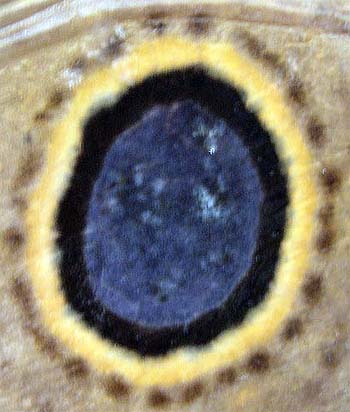
This ray is abundant and often landed along subtropical and tropical coasts and in local areas within the Mediterranean Sea. It is caught in commercial fisheries with bottom trawls and gill nets. It is also considered a game fish by recreational fishers.
Catch data is not generally collected for this species in particular but generally is reported in the “rays and skates” collective category. When marketed for human consumption, it is usually sold fresh.
Danger to Humans
The brown ray is considered harmless to humans.
Conservation
The brown ray is not listed on the World Conservation Union (IUCN) Red List as an endangered or threatened species. The IUCN is a global union of states, governmental agencies, and non-governmental organizations in a partnership that assesses the conservation status of species.
> Check the status of the brown ray at the IUCN website.
Geographical Distribution
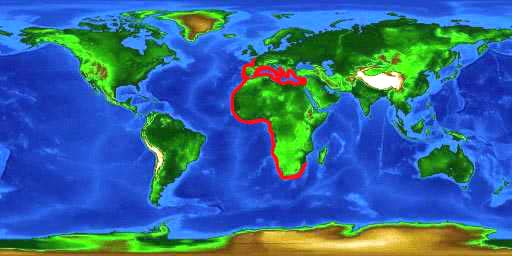
The brown ray is distributed subtropically in the eastern Atlantic Ocean from northern Portugal and throughout the Mediterranean, south to Madeira and South Africa. It is quite common on the continental shelf from Portugal throughout the Mediterranean and along the western and southeastern coasts of Africa. There is an unverified report from the Canary Islands. It has also been reported in the southwestern part of the Indian Ocean.
Habitat
This benthic fish is found in brackish and marine waters typically to depths of 985 feet (300 m), it is observed most commonly from 165-500 feet (50-150 m) in depth. The brown ray resides over soft bottom habitats along the coastal shelf and the uppermost slope.
Biology
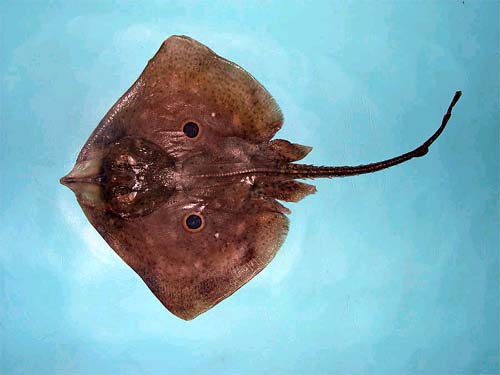
Distinctive Features
The brown ray has a short, bluntly pointed snout and a broad angular disc that is nearly quadrangular in shape. The pectoral fins are greatly enlarged and fused completely to the sides of the head, similar to most rays and skates. The tail is relatively short and has two dorsal fins.
This ray is easy to distinguish from its congeners in the eastern Atlantic Ocean by its tricolor eyespots located on the pectoral bases.
Coloration
The dorsal surface of the brown ray is ochre to reddish-brown with dark spots. There may be a small dark spot on the tip of the snout. There are two bright tricolor eyespots centered on the pectoral bases. These eyespots have a blue center and two concentric rings, the inner ring is purple and the outer ring is yellowish in color. The ventral surface is white.
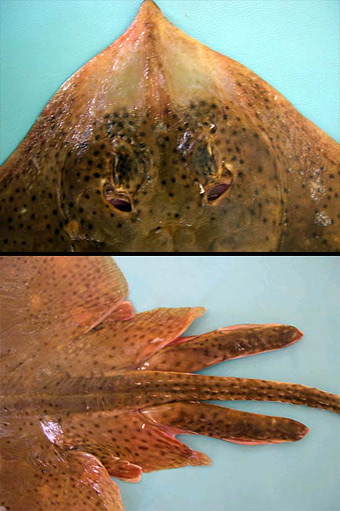
Dentition
The mouth of the brown ray contains teeth characteristic of the family Rajidae. The numerous small teeth are single-cusped and arranged in bands forming a pavement useful in crushing prey items.
Denticles
The upper surface of the brown ray is prickly in young individuals and nearly smooth in adult specimens with the exception of thorn pattern located on the back and tail which is variable. The skin along the ventral surface is smooth.
Size, Age, and Growth
Male brown rays reach a maximum total length of 24.8 inches (63.0 cm) while females reach a maximum of 23.5 inches (59.7 cm) total length. Males reach maturity at lengths of 15.7 inches (40 cm) total length and females at lengths of 17.3 inches (44 cm).
Food Habits
Prey items of the brown ray include a wide variety of benthic animals including small fish, crabs, shrimp and squid. The majority of its diet consists of small crustaceans.
Reproduction
The reproductive mode of the brown ray is oviparous. The egg capsules, measuring 1.7-1.8 inches (4.2-4.6 cm) long and 1.1-1.2 inches (2.7-2.9 cm) wide, are oblong in shape with stiff pointed horned corners. Female brown rays each release approximately 40-70 eggs in a single year. The eggs are deposited in sandy and muddy flats.
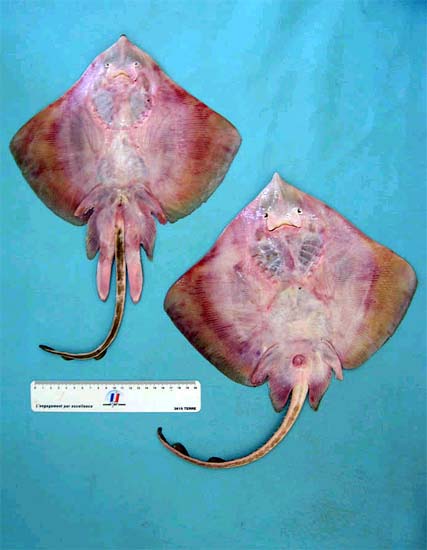
Predators
Potential predators of the brown ray include large fish such as sharks.
Parasites
Documented parasites from the brown ray include the monogean Acanthocotyle elegans found in the ray’s gills. Another reported parasite is Rajonchocotyle emarginata.
Taxonomy
Raja miraletus was originally described by Linnaeus in 1758. It is a member of the family Rajidae. Synonyms appearing in past scientific literature include Raja quadrimaculata Risso 1827 and Raia ocellifera Regan 1906. The genus name, Raja, is derived from the Latin “raja, -ae” meaning a sting ray.
Prepared by: Cathleen Bester